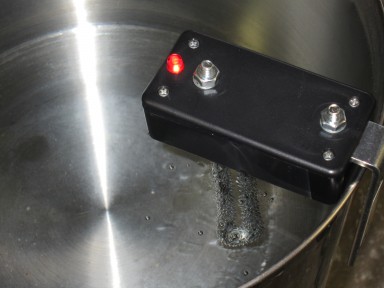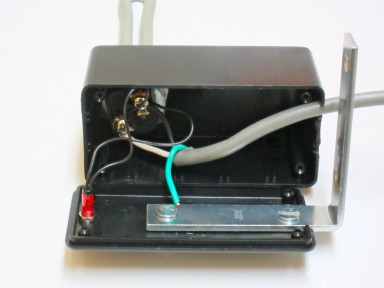Heat sticks are becoming popular among home brewers, and for good reason. Having two heated vessels really streamlines a brew day, and makes double brew days significantly less painful. And the economics of electric heat are compelling (in fact, that’s the way I’ve decided to go for the 7 bbl system at Two Mile). For example, to bring 5 gal (18.9 L) of water from 20°C to 80°C — a typical scenario for a home brewer heating strike liquor — requires 4.75 MJ of energy, costing roughly:
- Propane: (4.75 MJ * $7.33/kg)/(46.44 MJ/kg * 40%) = $1.87
- Electricity: (4.75 MJ * $0.117/kWh)/(3.6 MJ/kWh * 80%) = $0.19
Using current retail pricing, per Wikipedia, and assuming 80% efficiency for the electric system (which is really conservative) and 40% for propane (which is actually pretty optimistic). So the thing will pay for itself, and pretty quickly. As regular readers know, I’m always willing to jump on a bandwagon, especially if I can do it for less money and with less regard for aesthetics and/or safety.
All joking aside, working with 120 VAC circuits is inherently dangerous, and adding water doesn’t exactly help. I’m using a GFCI outlet, but having only one safety system between me and death doesn’t cut it. So I knew that I wanted the body of my heater to be plastic. I also wanted to be able to move it from kettle to kettle without using any tools, yet be able to mount it such that the element didn’t make contact with the kettle wall. Lastly, to allow for future tinkering, I didn’t want to have to solder or weld or epoxy anything together.
Parts list:
- 1440 W water heater element
- Grounded appliance cord (15 A minimum)
- 120 V lamp assembly (optional)
- ABS project enclosure (at least 1.5″ tall)
- 3″ x 3″ 90° angle bracket
- 2 ea. 1/4″-20 machine screws, nuts, and lock washers
- 1″ NPS stainless nut
It turns out that plumbing parts in 1″ NPS are hard to find, so I had to order the nut online. I’m guessing that in a bigger town I’d be able to find one at a dedicated plumbing supply shop. Everything else I was able to get from my local Radio Shack and Ace stores. Total cost was $39 since I had to buy a 1-1/4″ drill bit. So the unit should pay for itself after about 15 batches, not even accounting for getting my propane tanks refilled half as often. The first project enclosure I bought (pictured) turned out to be a little small at 1″ in height. While I was able to use a scrap piece of plastic to keep the element leads from contacting the mounting bracket, that approach made me a little uncomfortable and I ended up buying a 5″x2.5″x2″ box instead. With the lid and element nut/gasket tightened down, the unit isn’t quite water-tight, but should certainly stand up to some splashing.
The actual build is pretty self-explanatory and took less than an hour. I drilled the 1-1/4″ mounting hole for the element at one end of the project box, then used a Dremel rotary tool to cut away enough material at the other end for the angle bracket and power cord. I friction-fit the bracket and box around the lip of my thickest kettle before marking and drilling the two holes in the top of the project enclosure. One more hole near the element end of the box holds the panel-mount power indicator. That turned out to be pretty much redundant — as soon as the unit is plugged in the water around the element starts boiling.Wiring is equally simple. The live wires (black and white) of the extension cord are connected to the element, along with the power indicator, in parallel. The ground wire (green) is sandwiched between the mounting bracket and the lid. Since the angle bracket is in contact with the kettle (and therefore water), the GFCI will trip should anything that can be touched become “hot”.
That’s all there is to it. On a test run using 4.5 gal (17.1 L) of water, I was able to heat it from 4°C to a boil (92°C) in 100 minutes. That’s an average of 1050 W, or about 73% efficiency. Most of the losses can probably be attributed to the fact that I left the kettle open in order to keep an eye on the heater. Regardless, it’s a significant improvement over using propane.



Heat sticks are great I used them to heat my mash/sparge water here in winters of Minnesota. I was impressed how efficent and quiet it was. I would later boil out on my burner outside. About 3 yrs ago I kicked the propane habit all together and went all electric. No more brewing outside freezin my butt off. A couple of PID controllers and big elements make brewing easy, no more *&%# #@%!&* out of gas. The PID controllers are really cool you can use them for many brew projects. My favorite is, I built a fermentation chamber for outside to take advantage of our cold weather. I set the controller for say 50F a light bulb is a heat source and a exterior fan will pull in cold are if the temp rises more then 1F. I’ll do lagers in there since I do not have space in the keggerator. Another use is using a water bath and aquarium heater to slowly warm up a fermentor. My next project I’m thinking of adding a heat element in a tube to the mashtun to do a rims type thing. Brewing is a neat hobby the combination of art, science and math means endless projects to plan and build. Thanks for the great website and Brewstrong brother.
Sean,
Since the element isn’t totally submerged, will it have a shorter lifetime? I can’t tell by the pictures how much of it isn’t in the water, but I assumed they needed to be completely submerged so the dry portion won’t overheat.
If its no big deal, then this is definitely something I’ll build. I am constantly buying propane. I also overheat brewing liquor quite often, so I would probably add a temp. switch.
Great content, as always!
Thanks,
Kyle
Kyle,
In that picture maybe half an inch of the element is dry. In my experience with these low-power elements, a significant fraction of the element can be exposed without any short-term problems. Long-term, it probably isn’t great for the element, but they’re only $10, so I’m fine with replacing it every few years if that turns out to be the case.
Sean